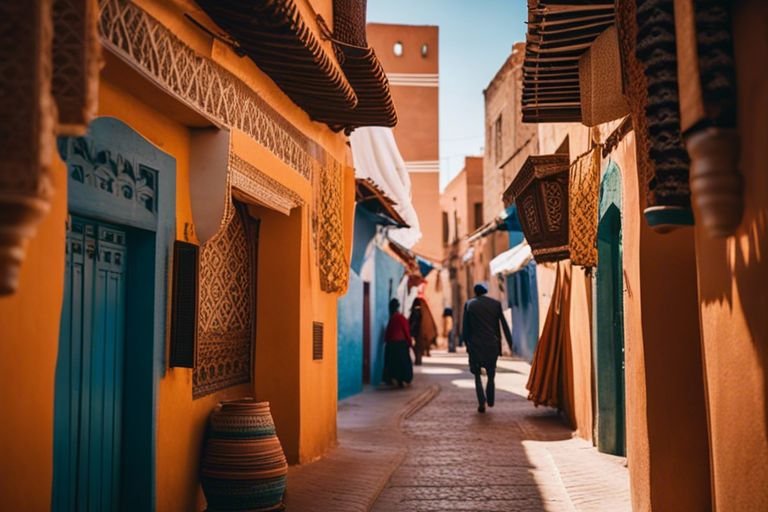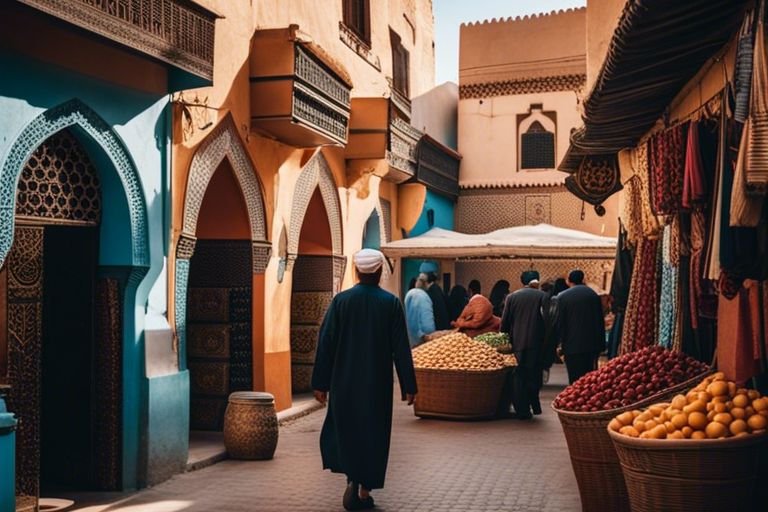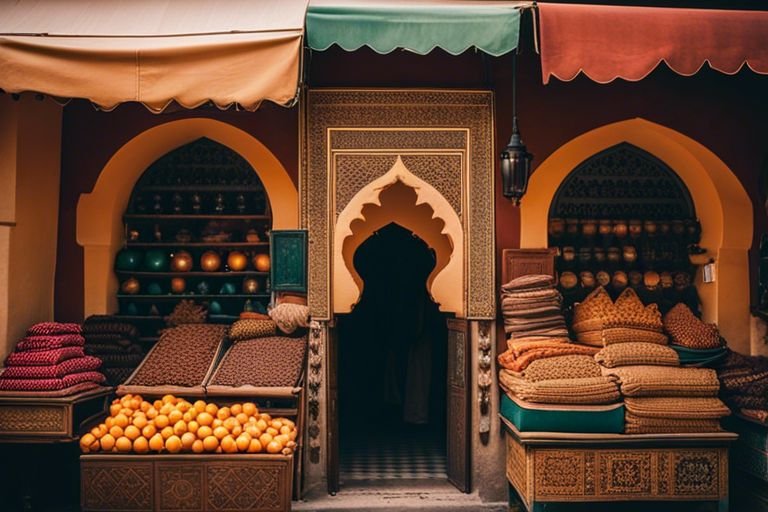With its rich history, stunning architecture, and unique blend of Arab, Berber, and European influences, Morocco is a country like no other. The vibrant culture of Morocco’s cities is a reflection of its diverse heritage, making it a must-visit destination for travelers looking to immerse themselves in a world of bustling souks, flavorful cuisine, and colorful traditions.
Advertisement
Key Takeaways:
- Rich history: Morocco’s cities are steeped in a rich history that can be felt as you explore the ancient medinas and architectural marvels.
- Diverse cuisine: From savory tagines to sweet pastries, Morocco offers a diverse and delicious culinary experience that reflects its cultural influences.
- Vibrant markets: The bustling souks in cities like Marrakech and Fez are a sensory delight, filled with colorful textiles, spices, and handicrafts.
- Art and craftsmanship: Moroccan cities are known for their exquisite craftsmanship in pottery, textiles, metalwork, and more, often displayed in beautifully decorated buildings.
- Hospitality and tea culture: Moroccans are renowned for their warm hospitality, often welcoming visitors with sweet mint tea, a symbol of friendship and tradition.
- Celebrations and festivals: Throughout the year, Morocco’s cities come alive with festivals celebrating music, dance, food, and religious events, offering a glimpse into the country’s vibrant culture.
- Architectural wonders: From the intricate tilework of the Royal Mansour in Marrakech to the ancient Roman ruins of Volubilis, Morocco’s cities are home to stunning architectural wonders that showcase the country’s diverse history and heritage.
Historical Context of Morocco’s Urban Development
From Ancient Medinas to Modern Metropolises
Any discussion on Morocco’s urban development must probe into the intricate history of its cities. The heart of many Moroccan cities lies in their ancient medinas, which are characterized by narrow alleys, bustling souks, and historic architecture dating back centuries. These medinas often serve as the focal point of urban life, where locals and tourists alike come to experience the rich cultural tapestry of Morocco.
As Morocco has evolved over the centuries, so have its cities. From the medieval medinas to the modern metropolises, urban development in Morocco reflects a blend of tradition and progress. The ancient city planning principles coexist with contemporary infrastructure, creating a unique urban landscape that is both visually captivating and culturally significant.
Colonial Influences and Post-Independence Evolution
Metropolises in Morocco, such as Casablanca and Rabat, bear the marks of colonial influences and post-independence evolution. During the 19th and 20th centuries, European powers established their presence in Morocco, leaving a lasting impact on its urban development. The architectural styles of French Art Deco and Spanish Moorish revival can be observed in many Moroccan cities, blending with traditional Moroccan design elements to create a distinct urban aesthetic.
This colonial legacy has influenced the spatial organization, infrastructure, and architectural styles of Moroccan cities, shaping the urban fabric we see today. Post-independence, Morocco initiateed on a journey of modernization and urbanization, leading to the development of new districts, infrastructure projects, and urban planning initiatives to meet the demands of a rapidly growing population and evolving urban landscape.

Architectural Marvels of Moroccan Cities
Iconic Mosques and Minarets
There’s a richness in the architectural heritage of Moroccan cities that is deeply intertwined with the country’s history and culture. One of the most iconic features of Moroccan cities is the intricate mosques and towering minarets that dot the skyline. These structures not only serve as places of worship but also stand as testaments to the craftsmanship and artistry of the Moroccan people.
Palaces, Gardens, and Riads
One of the most enchanting aspects of Moroccan cities is the presence of palaces, lush gardens, and traditional riads. These grand palaces, such as the Bahia Palace in Marrakech, showcase the opulence and grandeur of Morocco’s royal history. The peaceful gardens, like the Jardin Majorelle in Marrakech, offer a serene escape from the bustling city life. Riads, traditional Moroccan houses with inner courtyards, provide a glimpse into the intricate architectural styles and cultural traditions of the region.
One can experience the tranquil beauty of Moroccan palaces, gardens, and riads while exploring the vibrant city streets. These architectural marvels offer a unique blend of history, art, and nature that captivates the senses and immerses visitors in the rich culture of Morocco.
Contemporary Urban Structures
Minarets, at the heart of Moroccan cities, are not only architectural marvels but also symbols of religious devotion and cultural identity. These towering structures with their intricate designs and decorative details are a blend of traditional craftsmanship and aesthetic beauty.
Riads
Plus, Moroccan cities also boast a range of contemporary urban structures that showcase the country’s evolving architectural landscape. From modern skyscrapers to innovative urban designs, these structures add a dynamic element to the cityscape while harmoniously coexisting with the traditional architectural heritage of Morocco.

Cultural Tapestry of Moroccan Urban Life
Now let’s research into the rich and vibrant cultural tapestry of Moroccan urban life. From the bustling medina quarters to the lively souks and marketplaces, Morocco’s cities are a kaleidoscope of traditions, flavors, and celebrations that captivate visitors from around the world.
Medina Quarters: The Heartbeat of Tradition
One of the most enchanting aspects of Moroccan cities is their medina quarters, which are the ancient walled sections that house a maze of narrow alleys, bustling markets, and traditional riads. These vibrant neighborhoods encapsulate the essence of Moroccan culture, with locals going about their daily lives amidst the backdrop of ornate architecture, intricate tile work, and the aroma of spices lingering in the air.
Bustling Souks and Marketplaces
An integral part of Moroccan urban life, the bustling souks and marketplaces are where the pulse of the city can truly be felt. These vibrant hubs offer a sensory overload of sights, sounds, and smells, with vendors selling everything from colorful textiles and handcrafted ceramics to spices, leather goods, and traditional Moroccan handicrafts.
Life in Moroccan cities revolves around these lively marketplaces, where locals gather to socialize, haggle over prices, and immerse themselves in the vibrant atmosphere. Whether you’re in search of unique souvenirs or simply want to soak in the lively energy of the city, a visit to the souks is a must-do experience during your time in Morocco.
Festivals and Cultural Celebrations
With a calendar full of festivals and cultural celebrations, Moroccan cities truly come alive with music, dance, and colorful processions that honor age-old traditions and customs. From the lively street parades of the Mawazine Festival in Rabat to the spiritual Gnawa music festivals in Essaouira, these events offer a glimpse into the diverse tapestry of Moroccan culture.
With each city boasting its own unique festivals and celebrations, visitors have the opportunity to witness the richness and diversity of Moroccan traditions firsthand. Whether you’re exploring the vibrant streets of Marrakech or the historic squares of Fez, there’s always a cultural event to experience that will leave you enchanted and inspired.
Moroccan Cuisine: A Blend of Flavors in City Streets
Another integral part of Moroccan urban life is the diverse and flavorful cuisine that can be found in the bustling city streets. Moroccan food is a tantalizing blend of flavors influenced by Berber, Arab, and Mediterranean culinary traditions, with dishes like tagine, couscous, and pastilla tantalizing taste buds at every corner.
Blend in with the locals as you sample traditional street food favorites like merguez sausages, harira soup, and freshly baked msemen from street vendors and local eateries. The blend of aromatic spices and fresh ingredients combine to create a culinary experience that is as colorful and diverse as the cities themselves.
Artistic Expressions in Moroccan Cities
Traditional Crafts and Artisan Work
To truly experience the vibrant culture of Morocco’s cities, one must explore the traditional crafts and artisan work that are deeply intertwined with the country’s history. Each city boasts its own unique specialties, from the intricate ceramics of Fez to the vibrant tapestries of Marrakech. These age-old crafts are passed down through generations, with artisans dedicating their lives to perfecting their skills and preserving Morocco’s rich artistic heritage.
Modern Art and Gallery Scenes
The modern art scene in Moroccan cities is a dynamic and exciting reflection of the country’s evolving cultural landscape. Galleries in cities like Casablanca and Rabat showcase the works of contemporary Moroccan artists, who draw inspiration from both their heritage and global influences. These spaces serve as hubs for creativity and innovation, attracting art enthusiasts from around the world.
The contemporary art scene in Morocco is a melting pot of influences, blending traditional techniques with modern interpretations. Artists explore a wide range of mediums, from paintings and sculptures to multimedia installations, pushing the boundaries of artistic expression and sparking important conversations about identity, politics, and society.
Street Art and Urban Aesthetics
Traditional Moroccan cities are not just known for their ancient architecture and bustling markets – they also offer a vibrant canvas for street artists to showcase their talents. From the colorful murals of Tangier to the intricate mosaics of Chefchaouen, the streets come alive with creativity and self-expression. Street art in Morocco often carries powerful messages, reflecting the social and political realities of the country.
Street art has become a prominent aspect of Morocco’s urban landscape, with artists using public spaces to engage with the community and transform everyday environments into thought-provoking art installations. This fusion of traditional aesthetics and contemporary themes adds a dynamic layer to the artistic expressions found throughout Moroccan cities.
Religious and Spiritual Influences in Urban Settings
Once again, exploring the cities of Morocco unveils a tapestry woven with religious and spiritual influences that have shaped the rich culture of this North African country. From the call to prayer echoing through the narrow alleys to the ornate architecture of mosques, the presence of Islam is omnipresent in urban settings.
Islam’s Role in Shaping City Culture
Culture in Moroccan cities is profoundly intertwined with Islam – the predominant religion of the country. The architecture, daily routines, and social norms all bear the marks of Islamic teachings and practices. Mosque minarets dotting the skyline stand as a testament to the importance of religion in shaping the urban landscape.
Religious Festivals and Their Impact on Daily Life
For Moroccans, religious festivals play a significant role in their daily lives, bringing communities together in celebration and reflection. Festivals like Eid al-Fitr and Eid al-Adha mark important occasions in the Islamic calendar and are observed with fervor across the cities. These festivities not only hold religious significance but also impact the social fabric of urban life, fostering a sense of unity and belonging among residents.
Spiritual practices are not confined to mosques alone but permeate various aspects of daily life in Moroccan cities. From traditional rituals to Sufi gatherings, spirituality thrives in the hearts of the people, creating a unique atmosphere of reverence and devotion.
Coexistence of Faiths in Moroccan Cities
Impact. Despite Islam being the predominant religion in Morocco, the country has a long history of religious tolerance and coexistence. In cities like Marrakech and Fez, one can find mosques standing alongside churches and synagogues, symbolizing the peaceful cohabitation of different faiths. This harmonious blend of religions adds to the cultural diversity and richness of Moroccan urban life, making it a truly unique experience for visitors.
Plus, exploring the coexistence of faiths in Moroccan cities offers an enlightening perspective on how diverse beliefs can peacefully coexist and even thrive together. It serves as a reminder of the interconnectedness of humanity and the beauty that arises when people of different faiths come together in mutual respect and understanding.
Socio-Economic Dynamics in Morocco’s Cities
All across the vibrant cities of Morocco, there exists a complex web of socio-economic dynamics that shape the urban landscape. These dynamics are crucial in understanding the diverse and evolving nature of Moroccan society. To examine deeper into the heart of Morocco’s cities, one must first Discover the Wonders of Morocco.
The Tourism Industry and Its Effects on Urban Life
For decades, the tourism industry has played a significant role in shaping the urban fabric of Moroccan cities. The influx of tourists has brought economic prosperity to many areas, leading to the development of new infrastructure, hotels, and businesses. However, this rapid growth has also posed challenges such as gentrification, cultural commodification, and environmental strain.
Urbanization and Its Challenges
Socio-Economic dynamics in Moroccan cities are greatly influenced by rapid urbanization. As rural populations migrate to urban areas in search of better opportunities, cities face increasing pressure on resources, infrastructure, and social services. This urban growth often leads to issues like housing shortages, overcrowding, and inadequate public transportation systems.
Socio-Economic dynamics in Moroccan cities are greatly influenced by rapid urbanization. As rural populations migrate to urban areas in search of better opportunities, cities face increasing pressure on resources, infrastructure, and social services. This urban growth often leads to issues like housing shortages, overcrowding, and inadequate public transportation systems.
Empowerment and Civil Society in the City
Challenges related to empowerment and civil society are prevalent within the bustling cities of Morocco. While many efforts are being made to empower marginalized communities and strengthen civil society organizations, there are still hurdles to overcome. Issues such as political participation, gender equality, and socioeconomic disparities continue to shape the dynamics of urban life in Morocco.
The Future of Morocco’s Urban Centers
Many Morocco: Melting Pot of Cultures observers believe that the nation’s urban centers have a rich tapestry of history and modernity that must be carefully woven together for a harmonious future.
Preservation of Heritage and Contemporary Development
Any efforts to balance the preservation of Morocco’s rich heritage with the need for contemporary development are crucial in shaping the future of its urban centers. As Morocco continues to modernize, there is a growing focus on sustainable practices that respect and celebrate the country’s cultural legacy while meeting the needs of its growing population.
Sustainable Urban Planning Initiatives
Urban planners in Morocco are increasingly turning their attention to sustainable urban planning initiatives. These efforts aim to create more livable cities that integrate green spaces, efficient public transportation, and mixed-use development. By prioritizing sustainability, Morocco’s urban centers can reduce their environmental impact and enhance the quality of life for residents.
Urban sustainability in Morocco encompasses a range of strategies, from promoting pedestrian-friendly neighborhoods to investing in renewable energy sources. By implementing these initiatives, Morocco’s cities are taking proactive steps to ensure a more environmentally friendly and socially equitable future for all residents.
Emerging Trends and Innovations in City Living
Future urban centers in Morocco are likely to see the emergence of innovative trends that enhance city living. From smart technology integration to communal spaces that foster a sense of community, these innovations are reshaping the urban landscape and how residents interact with their surroundings.
Urban areas in Morocco are embracing a new era of connectivity and convenience, with advancements in transportation, communication, and infrastructure. By adapting to these emerging trends, Morocco’s cities are poised to become hubs of innovation and creativity in the region.
Embracing the Multifaceted Urban Culture of Morocco
The diverse urban culture of Morocco is a vibrant tapestry woven from centuries of history and influences from various civilizations. The dynamic blend of traditional Moroccan practices and contemporary trends creates a unique urban experience that attracts visitors and residents alike.
Morocco’s urban centers are not just physical spaces but living embodiments of the country’s rich cultural heritage. From the bustling markets of Marrakech to the historic medinas of Fez, each city has its own charm and character that reflects the multifaceted nature of Moroccan society.
Future Prospects and Continued Cultural Enrichment
Another important aspect of the future of Morocco’s urban centers is the continued cultural enrichment that comes from embracing diversity and fostering creativity. By nurturing local talent and supporting cultural initiatives, Morocco can ensure that its cities remain vibrant hubs of art, music, and literature.
Contemporary urban development in Morocco is not just about constructing buildings but about cultivating a sense of community and belonging. As the nation looks to the future, it is crucial to prioritize cultural preservation and enrichment to ensure that Morocco’s urban centers continue to thrive as dynamic cultural hubs.
Understanding the intricate balance between preserving heritage, fostering sustainability, embracing innovation, and enriching culture is crucial in shaping the future of Morocco’s urban centers. By recognizing the importance of these factors, Morocco can chart a course towards a more vibrant and inclusive urban landscape for generations to come.

FAQ
Q: What makes Morocco’s cities so vibrant?
A: Morocco’s cities are vibrant due to their rich history, diverse cultures, bustling markets, and colorful architecture.
Q: What are some must-visit cities in Morocco to experience its vibrant culture?
A: Some must-visit cities in Morocco to experience its vibrant culture include Marrakech, Fez, Casablanca, and Chefchaouen.
Q: What is the significance of the markets (souks) in Moroccan cities?
A: The markets, or souks, in Moroccan cities are significant as they offer a unique shopping experience where visitors can buy traditional handicrafts, spices, textiles, and souvenirs.
Q: What are some traditional dishes to try in Moroccan cities?
A: Some traditional dishes to try in Moroccan cities include tagine, couscous, pastilla, and mint tea.
Q: What cultural attractions can one explore in Moroccan cities?
A: Visitors can explore cultural attractions such as historic palaces, mosques, museums, and traditional riads in Moroccan cities.
Q: Is it safe to visit Moroccan cities as a tourist?
A: Yes, Moroccan cities are generally safe for tourists. However, it’s always advisable to take basic safety precautions and be aware of your surroundings.
Q: What is the best time of year to visit Morocco’s cities?
A: The best time to visit Morocco’s cities is during the spring (March to May) or fall (September to November) when the weather is mild and pleasant for exploring.

